Spanish atmosphere, UFOs and bats
Today we were continuing south from Colorado Springs to Santa Fe in New Mexico. This city is the highest located state capital in the United States with its 7,000 feet. The city is also the oldest city that is State Capital of Santa Fe was founded as a city by the Spanish in 1607! The city has America's oldest existing church building from 1610. This building is like many of the other buildings, built of adobe.
Lost in the maze
The goal of today's drive, Santa Fe could
be reached via motorway all the way, so we calculated on arriving sometime
mid-afternoon, so we had time to see the historical part of the city before it
would get dark. Because of our detour to car trouble the previous day, we spend
about an hour trying to locate a Hertz Office, but with no luck, so we headed
for the interstate and turned south.
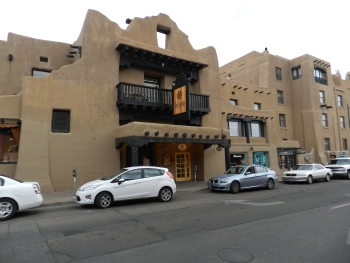 We drove south at a good pace and only paused to switch driver, and whatever
follows from it, and once to eat some food from our cooler. As we approached
Santa Fe, black clouds were towering on the horizon, and shortly before we
reached the city the rain began, but it didn't last long, and before we were at
the hotel, it had stopped raining. In Santa Fe we had booked a room in the La
Fonda on the Plaza, right in the center of town. Partly because I thought it
looked great online, but also because we only had a few hours in the city, and
as we would like to see the historic center, it would be nice to stay right
there. The hotel is located on the city's main square and about 100 yards from the
cathedral. Fortunately, you could park for free in the public parking garage,
which was next to the hotel when you stayed there, otherwise it would have been
impossible to find a spot to park.
We drove south at a good pace and only paused to switch driver, and whatever
follows from it, and once to eat some food from our cooler. As we approached
Santa Fe, black clouds were towering on the horizon, and shortly before we
reached the city the rain began, but it didn't last long, and before we were at
the hotel, it had stopped raining. In Santa Fe we had booked a room in the La
Fonda on the Plaza, right in the center of town. Partly because I thought it
looked great online, but also because we only had a few hours in the city, and
as we would like to see the historic center, it would be nice to stay right
there. The hotel is located on the city's main square and about 100 yards from the
cathedral. Fortunately, you could park for free in the public parking garage,
which was next to the hotel when you stayed there, otherwise it would have been
impossible to find a spot to park.
We arrived around 3 pm and Tim dropped me off outside the hotel. I went in and
got checked in while he waited in the car. I got the key to our room on the third
floor and a sticker to place in the car while it was in the parking garage, to
show that we stayed at the hotel. We had to drive around a bit before we found
an empty spot, but finally we managed. We took the bagage out of the car, to
take it to our room. In Seattle, we could not find our hotel, but that was not a
problem here. In stead we couldn't find our room! The elevator from the parking
garage only went to the second floor and our room was on the third. Out of the
elevator we tried to find a staircase, but the only one we could locate led
down only, not up, and then we were in a long corridor on the first floor. Here we
met a few hotel employees, but unfortunately they only spoke Spanish, so it
didn't help us much, as neither of us do. When we found a staircase that went
up, it led only to the second floor, where we came from, but somewhere else on
the floor, and with no connection to where we had arrived at by the elevator. We
gradually began to doubt whether third floor even existed. However, we met
another employee, who spoke broken English, and he explained that we had to
go down the hall to the right and then go up once more, so we tried that but with
no luck as there were
no stairs! After some wandering around the labyrinthine hotel where we at one
time also had strayed down to the basement, we met some people who could tell us
that if we were going further down the corridor we were in when we met them, and then
turned right, there would be an elevator that went to third floor.
Fortunately, it turned out that they were right, and when we got up there we
just took a wrong turn a few times before we found the rom.
The room was excellent, except for the view as the windows were
overlooking a backyard and a roof.
When we had established ourselves with all our paraphernalia, we went out to
look at the city. We took the elevator once more and rode down to the ground
floor. Then we just had to find our way through the hotel's maze of halls and
corridors to the lobby so we could finally get out in the open. Fortunately, we
managed without too much trouble, we only took a wrong turn once. Now, however, we knew
the layout of the hotel, so we got no further problems.
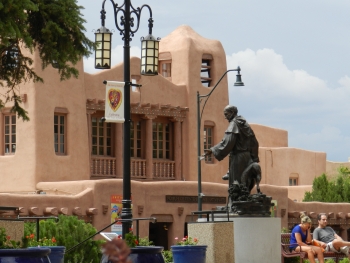 When we got out of the hotel we
walked the short distance to the Cathedral Basilica of Saint
Francis of Assissi, the city's Catholic cathedral. We visited the church and
admired the beautiful stained
glass windows and other decorations. Outside the church is a couple of statues, including one of Kateri Tekakwitha, a Native American woman who lived from 1656
to 1680. She belonged to the Mohawk tribe from New York State and was a Catholic and after her death miracles happened at her grave in
Canada. In 1980, she was beatified by Pope John Paul II and the current Pope,
Benedict XVI, canonized her as a saint on October 21st 2012 in St. Peter's Basilica in
Rome. She is thus the first North American Native American who has ever been canonized.
When we got out of the hotel we
walked the short distance to the Cathedral Basilica of Saint
Francis of Assissi, the city's Catholic cathedral. We visited the church and
admired the beautiful stained
glass windows and other decorations. Outside the church is a couple of statues, including one of Kateri Tekakwitha, a Native American woman who lived from 1656
to 1680. She belonged to the Mohawk tribe from New York State and was a Catholic and after her death miracles happened at her grave in
Canada. In 1980, she was beatified by Pope John Paul II and the current Pope,
Benedict XVI, canonized her as a saint on October 21st 2012 in St. Peter's Basilica in
Rome. She is thus the first North American Native American who has ever been canonized.
When we had seen enough of the church, we continued our tour around the city and looked
at some of the many other adobe buildings, that are plentiful here, including
the House
of the Governors, where the Spanish governors lived when the area belonged to
Spain. This building is located at
the central plaza, and there were many people gathered here, but later
even more got there. We had also seen the Opera House and the Museum of
Contemporary Art, both
from the outside. Along the way we passed a
restaurant that looked nice, and we decided to have dinner there later, but
first we returned to the hotel to relax. While we relaxed in our room, it was raining, but when we went
out again to dine, the sun
was shining. When we reached the plaza, there were performances by a Native
American band and later others performed as well, and the plaza was really
crowded. On our way to the restaurant we passed a memorial commemorizing the
terminus of the famous Santa Fe Trail.
At the restaurant we were served by
a young male waiter, although we would have preferred the pretty Native American girl
who also waited tables, but after dinner when we had to pay, we had a chat with both
of them, of
course based on a question of where we came from. We returned to the hotel, and
when it got darker I went outside again to take some pictures
of the illuminated cathedral.
No pictures
We were staying in New Mexico
for another few days. When we got to the state the day before, we were in doubt whether
to classify this state as "new" or not. A new state is one, we have never
visited before.We had both been here before, I twice,
but in neither case did the visit last more than three minutes as they took
place in the absolute northwestern corner of the state, at the Four Corners Monument,
where New Mexico is one of the four states that meet there. I decided later, that
I would not count it as "new" and so did Tim.
We left the labyrinthine hotel before
nine. The hotel was in a one-way street so we had to go through some smaller streets,
to get in the right direction, but we managed without problems. On the way out to the
highway, on which we had planned to go south, we filled our car with petrol for only $ 3.10
per gallon - the cheapest we had seen
so far on the trip. Shortly after we had filled up the car, we passed another gas
station that announced 2.95! After refueling, where we are also bought more ice
for the cooler, we found U.S. Route 285,
which we were going to follow all the way to Carlsbad, the goal of the day.
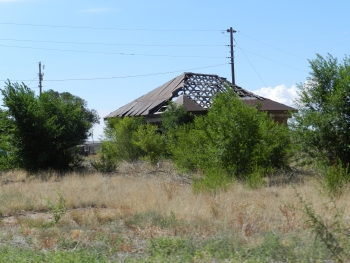 There is nothing much to say
about the first part of the trip. We drove through the
monotonous landscape that looked like the ones we had already seen in southern
Colorado and especially Nebraska. Dry, dry prairie with scorched grass and
mountains in the far distance. We were later told that it had not rained for eight
weeks and before that there had been an even longer drought, and the few cultivated fields, we passed
did not look
not too good. Corn fields were scorched before the plants had made "ears", and we heard
in the news on TV that this was the worst
drought since the "dust bowl" in the 1930s, and that it could end with
the same
disastrous consequences. The only "exciting" we saw on this part of the
trip were many, very long trains with three or four locomotives in front and one
or two behind. Many were empty, but there were also quite a lot, which was
filled with coal. We also passed a lot of trains that transported containers, among others, one with containers from Maersk
Line (Danish shipping company and the largest container shipping company in the
world), and one that pretty
much only had cointainere from the transportation company J.B. Hunt, whose trucks
we have often met in the eastern states.
There is nothing much to say
about the first part of the trip. We drove through the
monotonous landscape that looked like the ones we had already seen in southern
Colorado and especially Nebraska. Dry, dry prairie with scorched grass and
mountains in the far distance. We were later told that it had not rained for eight
weeks and before that there had been an even longer drought, and the few cultivated fields, we passed
did not look
not too good. Corn fields were scorched before the plants had made "ears", and we heard
in the news on TV that this was the worst
drought since the "dust bowl" in the 1930s, and that it could end with
the same
disastrous consequences. The only "exciting" we saw on this part of the
trip were many, very long trains with three or four locomotives in front and one
or two behind. Many were empty, but there were also quite a lot, which was
filled with coal. We also passed a lot of trains that transported containers, among others, one with containers from Maersk
Line (Danish shipping company and the largest container shipping company in the
world), and one that pretty
much only had cointainere from the transportation company J.B. Hunt, whose trucks
we have often met in the eastern states.
After approx. a three-hour drive, we reached Roswell, known for its
oil industry, irrigation, agriculture and dairy farming, but not least, known as
America's UFO capital. This is due to an alleged UFO crash landing or crash in
1947, which reportedly took place 75 miles from the town. Today Rockwell has a
UFO Museum and several shapes of green men with big heads on the streets and
elsewhere. We stopped at a gas station just inside the city
limits, not to refill, but to have lunch for ourselves out of the cooler. While
Tim made lunch I went into the shop to buy salt and pepper, which we had
previously managed without. In addition, I bought a cup of coffee and a bag
of gummi candy worms! These worms of course has a special story. First of all,
according to Danish taste, it is very difficult to get good wine gum og gummi
candy in the United States - it simply doesn't taste or feels right - compared
to our local variations. But on one of our visits to
Walmart, I had bought a bag of gummi candy worms, that tasted OK. After eating one I had placed
the bag in our cooled
glove compartment and forgotten all about them , but
one day we remebered them at started eating them. These Walmart worms were
quite small, so we were allowed two at a time, but only a few times morning and afternoon,
so the bag lasted for a long time, but now it was empty. The worms I bought at the
gas station was longer, so we christened them "one-worm worms" because we only allowed
ourselves one
at a time. Later it became almost an obsession that we should always have worms
in the glove compartment, and when we later approached New York, and was once
more out of worms, we felt that it was time to go home. We managed to buy
worms one more time though in a small shop in Queens, and when we returned the car at JFK airport, the only thing we
forgot to take with us was an unopened bag of worms in the glove compartment.
Well, after eating our lunch, we continued through town, where we took
pictures of both the UFO museum and some green Martian men. We didnt stop in
Roswell, but continued south to the smaller town of Artesia about 40 miles south
of Roswell. Here there was a very large oil refinery, actually the largest in
New Mexico. It was just off the main street so Tim wanted to take a picture. At this point I was driving
the car, so I pulled over to the side
of the road. Tim got out to take a
picture, but at the same time a car from the local sheriff drove up next to us. I
thought we were not allowed to park at the roadside and had already made ready
my "we are tourists, and didn't know" excuse, but he just rolled down the window of his car
and told Tim that he
was not allowed to to take pictures. Why we could
not photograph we never found out, because we have on previous holidays taken
several pictures of refineries, and so did we later on on this trip, but in
Artesia we did not.
A thunderstorm in the middle of the desert
We continued the last 35 miles to Carlsbad, where we arrived mid-afternoon. At the
north end of town is Living Desert Zoo and Gardens State Park and we would visit
there before we found
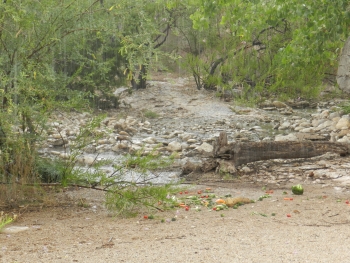 our
pre-booked hotel. The state park only shows animals and plants that are
found in the
Chihuahuan desert. Carlsbad is located in the northern
part of the desert, which extends down through Texas to Mexico. The place was
located on a hilltop 3,200 feet above sea level just outside town, and was
very easy to find. Entrance fee was a reasonable $ 5 per. person. Before we were allowed to go out and look at the animals and
plants, we got a longer explanation from the lady who sold us the tickets on what
we should see and which animals were found where. Then we were allowed to "escape". The first place we
got
to was their "birdhouse" and even Tim, who is somewhat ornithophobic, enjoyed the
sight of eagles and vultures, but he wouldn't enter the area where small
birds are flying free, so here I had to enter on my own. Here, I got to
take pictures of a roadrunner, like the ones
portrayed in the cartoons with Wile E. Coyote. In the cartoons the roadrunners
always says Beep Beep when they pass the coyote at lightning speed. In fact, they do not actually say beep beep, but coo coo.
our
pre-booked hotel. The state park only shows animals and plants that are
found in the
Chihuahuan desert. Carlsbad is located in the northern
part of the desert, which extends down through Texas to Mexico. The place was
located on a hilltop 3,200 feet above sea level just outside town, and was
very easy to find. Entrance fee was a reasonable $ 5 per. person. Before we were allowed to go out and look at the animals and
plants, we got a longer explanation from the lady who sold us the tickets on what
we should see and which animals were found where. Then we were allowed to "escape". The first place we
got
to was their "birdhouse" and even Tim, who is somewhat ornithophobic, enjoyed the
sight of eagles and vultures, but he wouldn't enter the area where small
birds are flying free, so here I had to enter on my own. Here, I got to
take pictures of a roadrunner, like the ones
portrayed in the cartoons with Wile E. Coyote. In the cartoons the roadrunners
always says Beep Beep when they pass the coyote at lightning speed. In fact, they do not actually say beep beep, but coo coo.
When I left the bird house Tim was waiting outside, and we went down to look at some javelinas. We
didn't see much of them though, as they hid inside a "cave". While we were here,
we were hit by a thunderstorm. Luckily there was a kind of lean-to where we could
seek shelter together with a Hispanic family, avoiding the worst rain. After a
while it calmed down so we
could move on. I hope for the locals, that it was the beginning of the end of the drought. We walked around and looked at bears, wolves, mountain
lions, lynxes, elks, prairie dogs, bison and several kind of snakes. In addition, we
passed different kinds of cacti, yuccas, agaves and other plants and we enjoyed the view
of the city. Even after the rain and thunder the humidity was very high, and as it was about
95 degrees, we decided to leave
and drive down to our hotel. Before we reached the hotel, we stopped at another Walmart where we
bought more cold cuts and fruit for the onward journey.
Below grounds
This Saturday, the 7th of July, it was 14 days since we
had left Denmark, so now half
of our vacation was over, but we still had many experiences yet to come, and
some of them already later that same day, when we had planned to visit the caves in Carlsbad, or
rather somewhat southwest of town in Carlsbad Caverns National Park. For some
reason Tim's and my visits to national parks always end up being on
weekends, where they are plenty of other people in the parks. It happened in 2010 in both the Grand
Canyon and Yellowstone, and it had already happened in Glacier on this trip and
now it happened once again. Fortunately, it was not as bad as we had feared.
We got up at 7 to get ready for the day's outing and at 8.30 we left the
hotel to go to Carlsbad Caverns National Park, ca. 20 miles southwest of town.
Thirty minutes later we entered the national park, which has a no fee entrance for a
change. On the other hand you have to pay to get down to the caves, but
here we could use our annual pass. From the entrance to the national park there
are still some miles to the entrance to the caves, and along the way we saw an
exit to a scenic drive, that we agreed that we would take on the way down. The
park contains 117 caves, but only three are open to the public and the two
required guided tours. The last, which is just called Carlsbad Caverns has
both guided and self-guided tours, and it was the one we would visit. We found a
car park - there were already many people - and went into the combined ticket
office, museum, visitor center and souvenir shop.
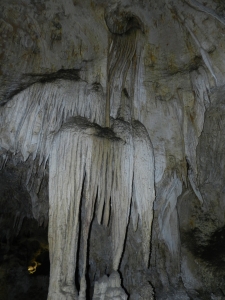 Here
we got two tickets and then we were escorted
to the elevators. That is to say, before we were given tickets, we were asked if
we had visited caves east of the Mississippi within the last seven years. We had
not, so we got our tickets. When we read about the place on the net, we had been
warned that there could be a long waiting line to get down into the caves because the
large elevators was undergoing renovations, and therefore only two small
ones were working. When we came to the "waiting room" for the lifts, there was however nobody
else, so
we were first in line. Eventually, more people arrived, but no more than that all
could be stowed into the two elevators that returned from the depths. The lifts are
going 750 feet down the mountain and when the doors opened, we stepped out into a cave, which was
equipped with - guess once - a souvenir shop and a cafe that also sold
souvenirs. In the cave you can take two self-guided tours, Big Room Tour and the
Natural Entrance Tour. The Natural
Entrance Tour, which is only a mile long, is recommended only for people in a
very good condition, as you have to walk quite a distance uphill. In fact, so much that it
corresponds to taking the stairs up to the 80th floor. In the
brochure it says that you should expect to spend 3-4 hours to walk the one mile
up to
the entrance. You can also walk down this path, but as we were down, this
was not an option.
Here
we got two tickets and then we were escorted
to the elevators. That is to say, before we were given tickets, we were asked if
we had visited caves east of the Mississippi within the last seven years. We had
not, so we got our tickets. When we read about the place on the net, we had been
warned that there could be a long waiting line to get down into the caves because the
large elevators was undergoing renovations, and therefore only two small
ones were working. When we came to the "waiting room" for the lifts, there was however nobody
else, so
we were first in line. Eventually, more people arrived, but no more than that all
could be stowed into the two elevators that returned from the depths. The lifts are
going 750 feet down the mountain and when the doors opened, we stepped out into a cave, which was
equipped with - guess once - a souvenir shop and a cafe that also sold
souvenirs. In the cave you can take two self-guided tours, Big Room Tour and the
Natural Entrance Tour. The Natural
Entrance Tour, which is only a mile long, is recommended only for people in a
very good condition, as you have to walk quite a distance uphill. In fact, so much that it
corresponds to taking the stairs up to the 80th floor. In the
brochure it says that you should expect to spend 3-4 hours to walk the one mile
up to
the entrance. You can also walk down this path, but as we were down, this
was not an option.
We therefore decided
for the Big Room Tour. The walk is about one and quarter mile long
and even if it starts out flat (here you can see the cave from a wheelchair), it
later goes a bit up and down. The tour is a loop, so you end up the same
place as you start, and the way you pass a lot of stalactites. We did too,
and we took pictures of virtually every formation, we passed. But when you
look at the pictures they are actually quite monotonous, even if while down there you think
you really have taken something that is different, and as with other rocks, such
as the Grand Canyon or the Badlands, the pictures don't give a fair impression of what you see. We saw everything
there is to see and
talked about how peaceful it would be if parents could read - and get their kids to
listen. It said on big signs that you should avoid high voices and whisper instead,
but that didn't stop several children from shouting and screaming and that
removed a bit of
the peace.
Almost two hours later we had been all the way around, and we took the
elevator back up. We visited the souvenir shop and museum, and then we took off
again. As we had decided in advance, we took the scenic drive, which turned out
to be a dirt road, where they had forgotten to put gravel in several places, so
it was somewhat uneven! In several places we were almost afraid that the car
would be shaken to pieces, or that we would be, and I wondered whether or not a
warning for the mandatory use of kidney belts would be appropriate. The National
Park is known for its many birds. Of the 500 species found in New Mexico, you
can see 300 in the park. We didn't see that many, but we saw a lot even if I was not able to determine the species of them.
The only thing I did recognize was a bunch of turkey vultures circling over the
car probably waiting for it to break down, so they could have their dinner. But we cheated them,
and I took a few pictures of them, even though they were not particularly
helpful. Every time I had focus on them, they moved - those ungrateful beasts.
When we got down, the trip had taken just over an hour, and I have since read on
the Web, that this is what it is expected take. Along the way we thought, however, that we
were
not really getting anywhere, so we turned on the GPS to see if we were driving
in the right direction - and it turned out that it actually knew the road!
An interesting thing about the drive was that at the entrance there was a sign that said the
road was one-way from the caves to the main road, the direction we were going. On the
whole trip down we met only four or five cars, and they drove in the opposite
direction,
which seemed a little odd.
Well down from the mountains we drove back to the main road and Carlsbad with a single stop at an
old trading post that I wanted to take picture of. When we got
back to town, we drove up to the Living Desert again, not to visit the park
again, but to see where the road it was on was leading. The road turned out to
pass some
very large and judged by their appearance quite expensive homes. The road went steeply downhill at a time, and here we met two young guys who
obviously wanted to take the hill on skateboards, but when they saw us, they
waited until we were gone. At the foot of the hill a car and two young girls
were waiting - apparently
the guys we showing of to the girls a bit :-). The road eventually led back to town.
400,000 bats
Out at the caves I had noticed
that their bat-program would begin at 7.45 and I would like to see that. We
therefore dined quite early, and while dining Tim decided not to join me, as he
thought it would be too hot, to be benched in the evening sun.
Instead I left him on the hotel then drove back to the caves by myself, parked the car and walked down to the
"bat cave" entrance. Here there is an amphitheater, where you can sit on
stone benches and enjoy the bats leaving the cave at sunset. At seven-thirty
a park ranger began an introduction. She was a nice girl, but could not compete with
the park ranger from Little Big Horn! On the other hand - and more important - she
told us a lot of interesting stuff about "her" bats. She started with some practical observations,
as the show
didn't start until 7.45, Among other things, filming og taking pictures were not
allowed and that cell phones had to be turned of when the bats began to
fly as electronics could interfere with the small animal's "echo-system" or sonar or
whatever they use. Therefore, I have no pictures of the little critters.
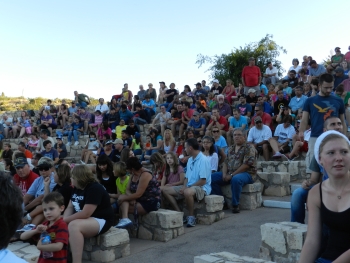 Exactly at
7.45
the ranger started her official talks, in which she
told us about the bats that lived in the cave, and why they were very careful to
ask, if
you had been in other caves recently. Many bats in the east is infected with a deadly
disease, "white nose syndrome", and up to 7 million bats in the eastern United
States have died from the disease. As their own bats is free of the disease, they
want to keep it that way, and don't want the infection introduced by tourists. Consequently, if you
answer yes to the question of a cave visit, you will be asked if you wore the
same clothes, and if positive, you will be asked to put
on a full body suit.
Exactly at
7.45
the ranger started her official talks, in which she
told us about the bats that lived in the cave, and why they were very careful to
ask, if
you had been in other caves recently. Many bats in the east is infected with a deadly
disease, "white nose syndrome", and up to 7 million bats in the eastern United
States have died from the disease. As their own bats is free of the disease, they
want to keep it that way, and don't want the infection introduced by tourists. Consequently, if you
answer yes to the question of a cave visit, you will be asked if you wore the
same clothes, and if positive, you will be asked to put
on a full body suit.
The ranger had already in her opening remarks
predicted that the bats would wake up around 8.15 and start to leave the cave a
few minutes later. While we waited, she killed some myths about bats, for example,
that they all are vampires. Actually only three species of bats out of
1,250 different existing species suck blood (one of these only the blood from
birds), and they all live in Central and South
America. One species that lives in Mexico and California eat small fish and
shellfish and only one species eats blood from mammals, mostly cattle. Actually the
"blood sucking bats" do not suck blood like "vampires". They
"cut" a small hole in the skin, which then bleed and then lick the blood up with
the tongue. In turn the saliva of these bats contains different
substances that prevents blood from clotting when they have
bitten a hole, and today experiments are done with these substances to find out
if they can be used to prevent blood
clots in humans. Most bats eat other kind of food though. 70 % of all bats eat insects, while
almost 30 % are vegetarians and only eat fruits and berries. The bats in Carlsbad, however,
are insectivores, that primarily feed on
moths and mosquitoes, and we were actually recommended to build a bat nest in a
tall tree in our garden, if we were bothered by mosquitoes. Also the myth that bats
infects humans with rabies was busted. Only ½ percent of all vampire bats are infected
with rabies, and they all live in South America.
Some microphones in the cave where bats sleep, senses when they wake up. The
first who wakes up begins to make clicking sounds that arouse others who then makes
clicking sounds, until all are awake. Once they have gotten themselves together they fly
out of the cave. The microphones were connected to a speaker system outside, and at
8.20 we heard the first clicking sounds. The ranger turned of off the speaker system,
and told us that now it would not last long, and then around 1,000 people
waited in
devout silence, spending their Saturday night to watch for some 2 inches long (+
2 inches of tail) bats to leave the cave. At 8.25, the first
animals left and they just kept coming. Bats galore, flew out of the cave,
circled a few times and then flew up over the cliff in a steady stream to look
for food. When it got so dark that I could not see more bats, I left the place, which
many others had already done, but the stream of bats was not yet over.
Approximately 400,000 bats spend the night in the cave, and they have to go out
and eat. The species of bats living in the cave is called Mexican Freetailed Bat,
but actually 17 different species of bats are found in the national park. I drove back to
Carlsbad and along the way I filled up the car, so we
were ready for the next day's drive to Texas, and I was back at the hotel at
approx. 22.00 after a very exciting evening.
-
Return to Cross Country Tour -
- Return to
Travel stories -